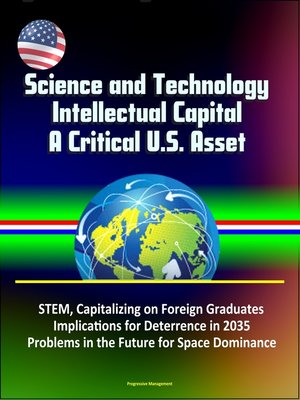Science and Technology Intellectual Capital, a Critical U.S. Asset
ebook ∣ STEM, Capitalizing on Foreign Graduates, Implications for Deterrence in 2035, Problems in the Future for Space Dominance
By Progressive Management

Sign up to save your library
With an OverDrive account, you can save your favorite libraries for at-a-glance information about availability. Find out more about OverDrive accounts.
Find this title in Libby, the library reading app by OverDrive.



Search for a digital library with this title
Title found at these libraries:
| Loading... |
This excellent report has been professionally converted for accurate flowing-text e-book format reproduction. The potential for losing intellectual dominance in science and technology is a major threat to the ability of the US to maintain national security and economic superiority. The US must ensure it exercises the best possible options to grow, attract and maintain enough qualified individuals to stay ahead of all adversaries. In addition to expanding the base of technology-educated individuals, the threats to the intellectual capital base must be countered in order to secure US ability to deter actions of adversaries. The primary measure of intellectual capital development is the number of undergraduate and graduate degrees earned in science, technology, engineering and mathematics (STEM). It is imperative for the US to focus now on doing what is necessary to maintain educational excellence and post-education opportunities to ensure the US knowledge base in science and technology will remain the strongest in the world.
This paper will examine many aspects influencing the future of US intellectual capital. The first chapter will present the strategic importance of growing, attracting, and retaining graduate-level STEM professionals. This includes first, second and third order effects of having or, conversely, losing US intellectual capacity. Chapter two addresses current trends and specifically addresses the importance of benefiting from foreign-born students and workers. This chapter includes statistics regarding graduate degrees granted in the US to both US citizens and non-US citizens. Chapter three presents initiatives to ensure the US will have a robust technology-educated core in future years. Finally, chapter four lays out potential impacts. It specifically addresses the ability for the US to stay at the cutting edge of innovation and the correlation of maintaining STEM intellectual capacity to countering or deterring technically advanced threats. The exponential growth of technology combined with rapid globalization point to a future which requires the US to have an advantage in science and technology intellectual capital. Without this resource, the US will be at a disadvantage in many areas, including national security and economic stability. To best prepare for future threats, the US needs to keep priority on growing, attracting and maintaining graduate-level technical capacity.
INTRODUCTION * CHAPTER 1 * The Importance of STEM Intellectual Capital * CHAPTER 2 * Current Status and Trends * Capitalizing on Foreign Graduates * CHAPTER 3 * Existing Initiatives * CHAPTER 4 * Implications for Deterrence in 2035 * Space as a Case Study: US May Not Have Advantage in 2035 * CONCLUSION * ENDNOTES * BIBLIOGRAPHY






